Nursing Assignment: Health Assessment, Vital Signs & Communication
VerifiedAdded on 2023/04/06
|5
|919
|159
Report
AI Summary
This nursing assignment provides a critique of a simulated health assessment, addressing normal health parameters and effective communication techniques. It outlines the requirements for a primary health assessment, including normal ranges for blood pressure, temperature, respiration, pulse rate, and oxygen saturation in adults, as well as variations in these parameters for a 72-year-old and a child aged 6-10 years. The assignment also explores crucial communication techniques for accurate health assessment, such as introduction, maintaining eye contact, guided questioning, active listening, providing wait time, offering transitions, and encouraging patient empowerment. The importance of these techniques in building patient trust and ensuring comprehensive care is emphasized, with references to relevant research and publications.
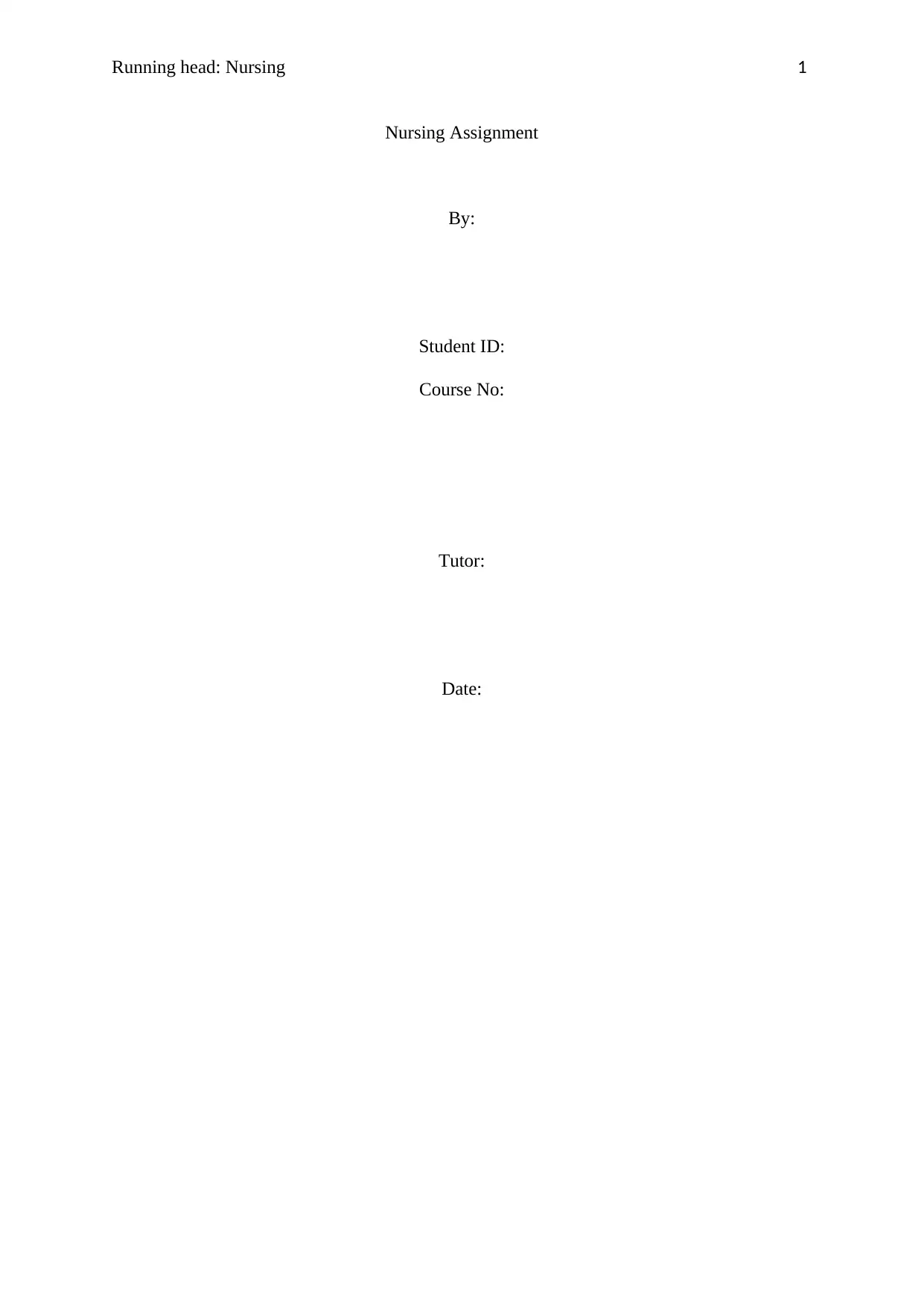
Running head: Nursing 1
Nursing Assignment
By:
Student ID:
Course No:
Tutor:
Date:
Nursing Assignment
By:
Student ID:
Course No:
Tutor:
Date:
Paraphrase This Document
Need a fresh take? Get an instant paraphrase of this document with our AI Paraphraser
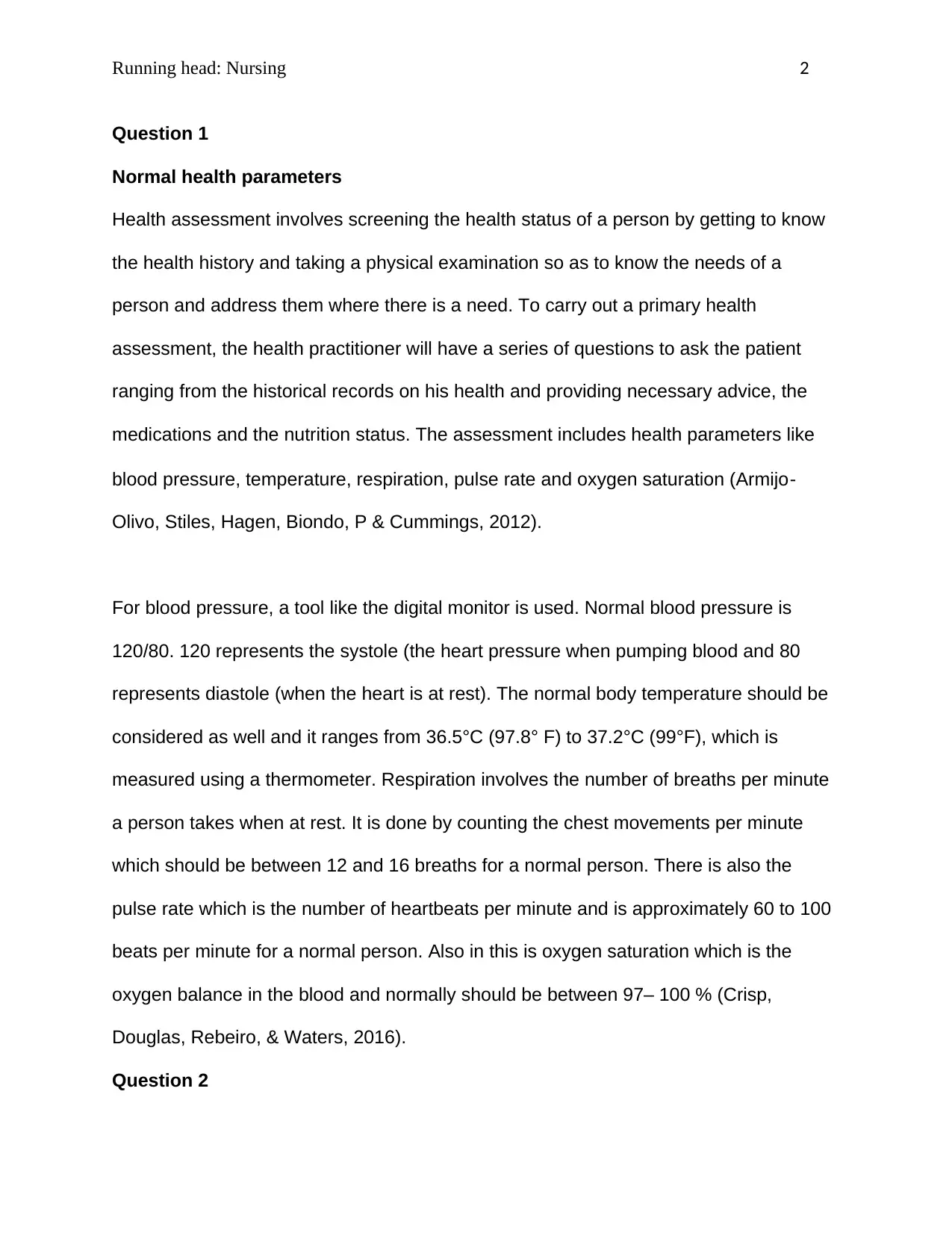
Running head: Nursing 2
Question 1
Normal health parameters
Health assessment involves screening the health status of a person by getting to know
the health history and taking a physical examination so as to know the needs of a
person and address them where there is a need. To carry out a primary health
assessment, the health practitioner will have a series of questions to ask the patient
ranging from the historical records on his health and providing necessary advice, the
medications and the nutrition status. The assessment includes health parameters like
blood pressure, temperature, respiration, pulse rate and oxygen saturation (Armijo‐
Olivo, Stiles, Hagen, Biondo, P & Cummings, 2012).
For blood pressure, a tool like the digital monitor is used. Normal blood pressure is
120/80. 120 represents the systole (the heart pressure when pumping blood and 80
represents diastole (when the heart is at rest). The normal body temperature should be
considered as well and it ranges from 36.5°C (97.8° F) to 37.2°C (99°F), which is
measured using a thermometer. Respiration involves the number of breaths per minute
a person takes when at rest. It is done by counting the chest movements per minute
which should be between 12 and 16 breaths for a normal person. There is also the
pulse rate which is the number of heartbeats per minute and is approximately 60 to 100
beats per minute for a normal person. Also in this is oxygen saturation which is the
oxygen balance in the blood and normally should be between 97– 100 % (Crisp,
Douglas, Rebeiro, & Waters, 2016).
Question 2
Question 1
Normal health parameters
Health assessment involves screening the health status of a person by getting to know
the health history and taking a physical examination so as to know the needs of a
person and address them where there is a need. To carry out a primary health
assessment, the health practitioner will have a series of questions to ask the patient
ranging from the historical records on his health and providing necessary advice, the
medications and the nutrition status. The assessment includes health parameters like
blood pressure, temperature, respiration, pulse rate and oxygen saturation (Armijo‐
Olivo, Stiles, Hagen, Biondo, P & Cummings, 2012).
For blood pressure, a tool like the digital monitor is used. Normal blood pressure is
120/80. 120 represents the systole (the heart pressure when pumping blood and 80
represents diastole (when the heart is at rest). The normal body temperature should be
considered as well and it ranges from 36.5°C (97.8° F) to 37.2°C (99°F), which is
measured using a thermometer. Respiration involves the number of breaths per minute
a person takes when at rest. It is done by counting the chest movements per minute
which should be between 12 and 16 breaths for a normal person. There is also the
pulse rate which is the number of heartbeats per minute and is approximately 60 to 100
beats per minute for a normal person. Also in this is oxygen saturation which is the
oxygen balance in the blood and normally should be between 97– 100 % (Crisp,
Douglas, Rebeiro, & Waters, 2016).
Question 2
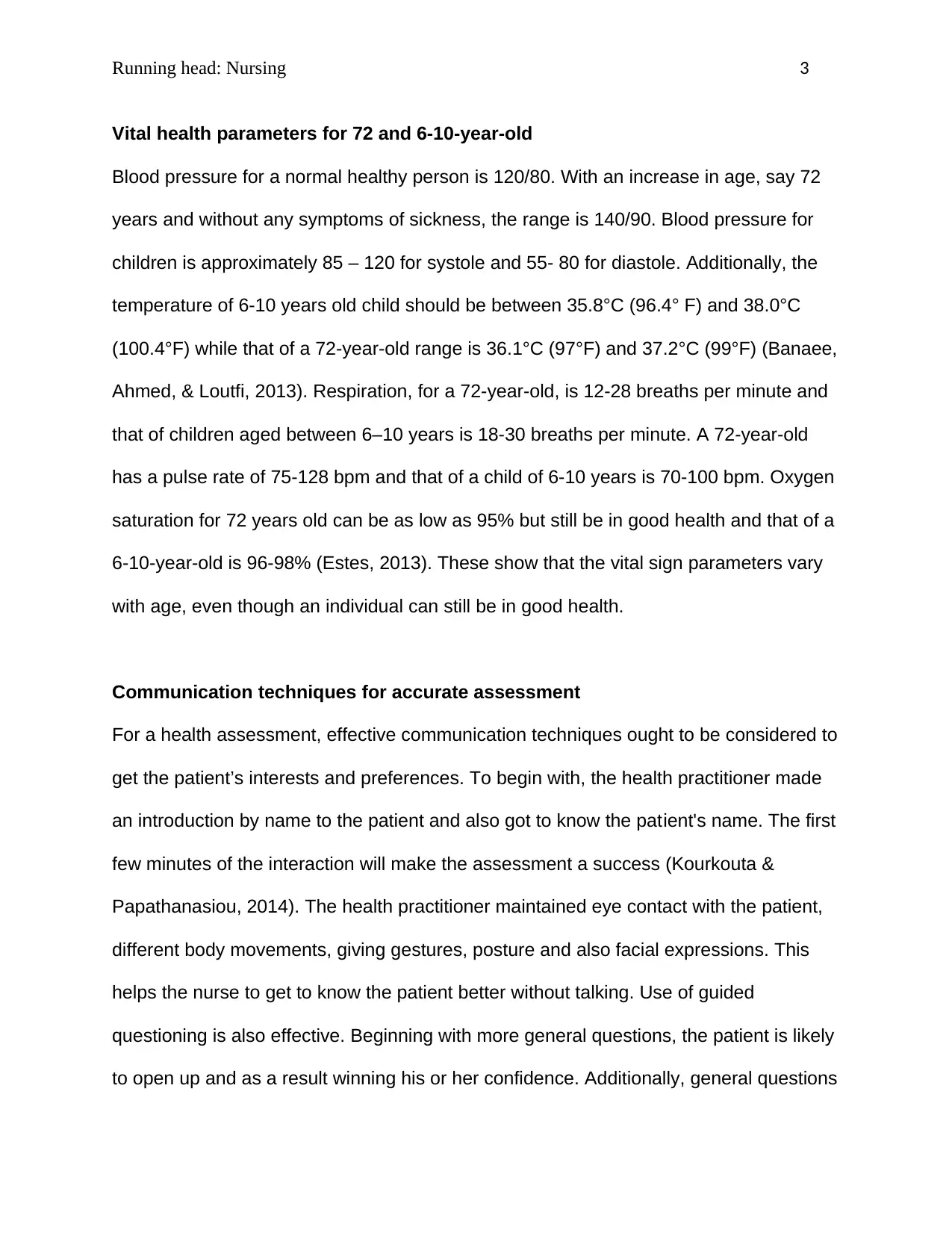
Running head: Nursing 3
Vital health parameters for 72 and 6-10-year-old
Blood pressure for a normal healthy person is 120/80. With an increase in age, say 72
years and without any symptoms of sickness, the range is 140/90. Blood pressure for
children is approximately 85 – 120 for systole and 55- 80 for diastole. Additionally, the
temperature of 6-10 years old child should be between 35.8°C (96.4° F) and 38.0°C
(100.4°F) while that of a 72-year-old range is 36.1°C (97°F) and 37.2°C (99°F) (Banaee,
Ahmed, & Loutfi, 2013). Respiration, for a 72-year-old, is 12-28 breaths per minute and
that of children aged between 6–10 years is 18-30 breaths per minute. A 72-year-old
has a pulse rate of 75-128 bpm and that of a child of 6-10 years is 70-100 bpm. Oxygen
saturation for 72 years old can be as low as 95% but still be in good health and that of a
6-10-year-old is 96-98% (Estes, 2013). These show that the vital sign parameters vary
with age, even though an individual can still be in good health.
Communication techniques for accurate assessment
For a health assessment, effective communication techniques ought to be considered to
get the patient’s interests and preferences. To begin with, the health practitioner made
an introduction by name to the patient and also got to know the patient's name. The first
few minutes of the interaction will make the assessment a success (Kourkouta &
Papathanasiou, 2014). The health practitioner maintained eye contact with the patient,
different body movements, giving gestures, posture and also facial expressions. This
helps the nurse to get to know the patient better without talking. Use of guided
questioning is also effective. Beginning with more general questions, the patient is likely
to open up and as a result winning his or her confidence. Additionally, general questions
Vital health parameters for 72 and 6-10-year-old
Blood pressure for a normal healthy person is 120/80. With an increase in age, say 72
years and without any symptoms of sickness, the range is 140/90. Blood pressure for
children is approximately 85 – 120 for systole and 55- 80 for diastole. Additionally, the
temperature of 6-10 years old child should be between 35.8°C (96.4° F) and 38.0°C
(100.4°F) while that of a 72-year-old range is 36.1°C (97°F) and 37.2°C (99°F) (Banaee,
Ahmed, & Loutfi, 2013). Respiration, for a 72-year-old, is 12-28 breaths per minute and
that of children aged between 6–10 years is 18-30 breaths per minute. A 72-year-old
has a pulse rate of 75-128 bpm and that of a child of 6-10 years is 70-100 bpm. Oxygen
saturation for 72 years old can be as low as 95% but still be in good health and that of a
6-10-year-old is 96-98% (Estes, 2013). These show that the vital sign parameters vary
with age, even though an individual can still be in good health.
Communication techniques for accurate assessment
For a health assessment, effective communication techniques ought to be considered to
get the patient’s interests and preferences. To begin with, the health practitioner made
an introduction by name to the patient and also got to know the patient's name. The first
few minutes of the interaction will make the assessment a success (Kourkouta &
Papathanasiou, 2014). The health practitioner maintained eye contact with the patient,
different body movements, giving gestures, posture and also facial expressions. This
helps the nurse to get to know the patient better without talking. Use of guided
questioning is also effective. Beginning with more general questions, the patient is likely
to open up and as a result winning his or her confidence. Additionally, general questions
⊘ This is a preview!⊘
Do you want full access?
Subscribe today to unlock all pages.

Trusted by 1+ million students worldwide
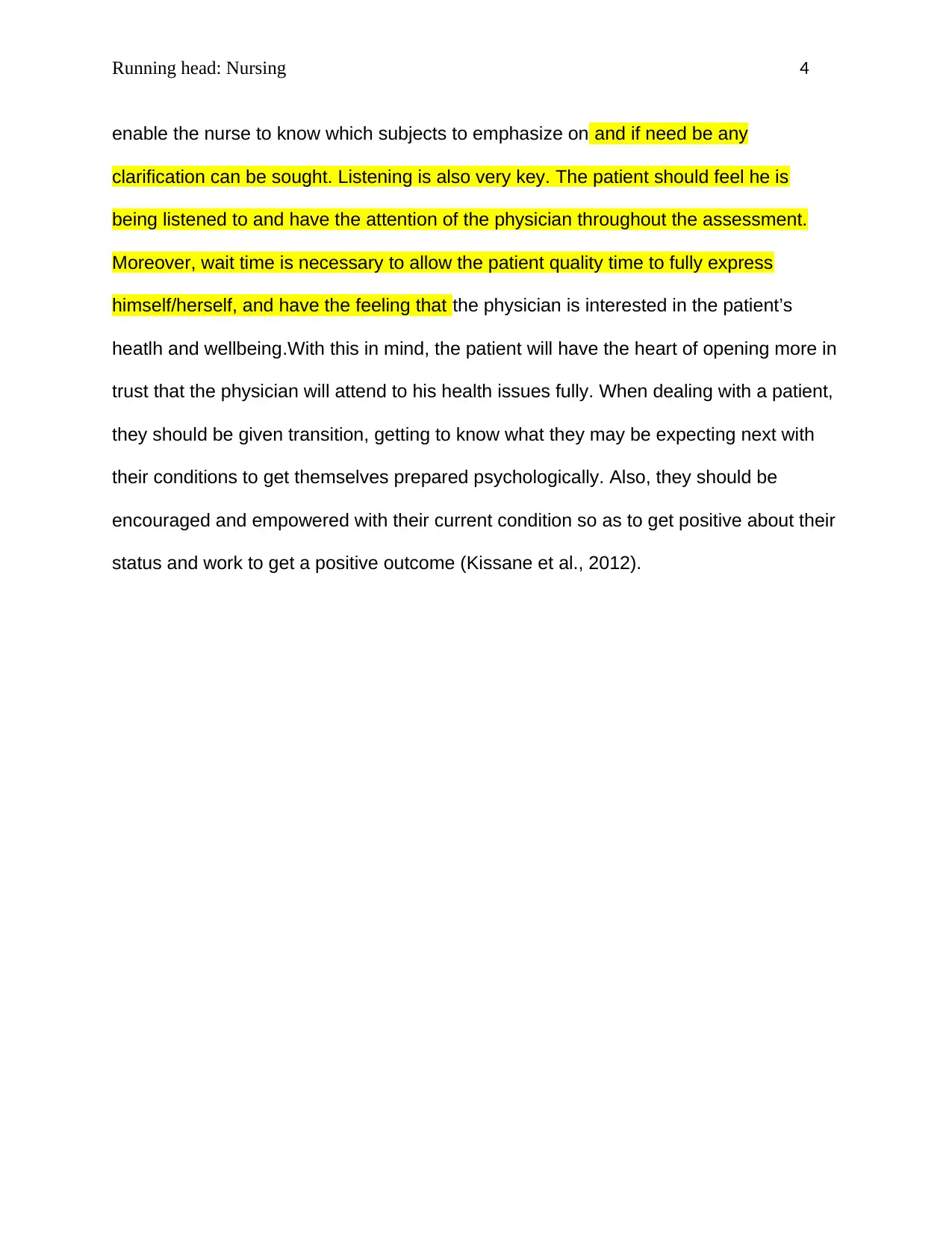
Running head: Nursing 4
enable the nurse to know which subjects to emphasize on and if need be any
clarification can be sought. Listening is also very key. The patient should feel he is
being listened to and have the attention of the physician throughout the assessment.
Moreover, wait time is necessary to allow the patient quality time to fully express
himself/herself, and have the feeling that the physician is interested in the patient’s
heatlh and wellbeing.With this in mind, the patient will have the heart of opening more in
trust that the physician will attend to his health issues fully. When dealing with a patient,
they should be given transition, getting to know what they may be expecting next with
their conditions to get themselves prepared psychologically. Also, they should be
encouraged and empowered with their current condition so as to get positive about their
status and work to get a positive outcome (Kissane et al., 2012).
enable the nurse to know which subjects to emphasize on and if need be any
clarification can be sought. Listening is also very key. The patient should feel he is
being listened to and have the attention of the physician throughout the assessment.
Moreover, wait time is necessary to allow the patient quality time to fully express
himself/herself, and have the feeling that the physician is interested in the patient’s
heatlh and wellbeing.With this in mind, the patient will have the heart of opening more in
trust that the physician will attend to his health issues fully. When dealing with a patient,
they should be given transition, getting to know what they may be expecting next with
their conditions to get themselves prepared psychologically. Also, they should be
encouraged and empowered with their current condition so as to get positive about their
status and work to get a positive outcome (Kissane et al., 2012).
Paraphrase This Document
Need a fresh take? Get an instant paraphrase of this document with our AI Paraphraser
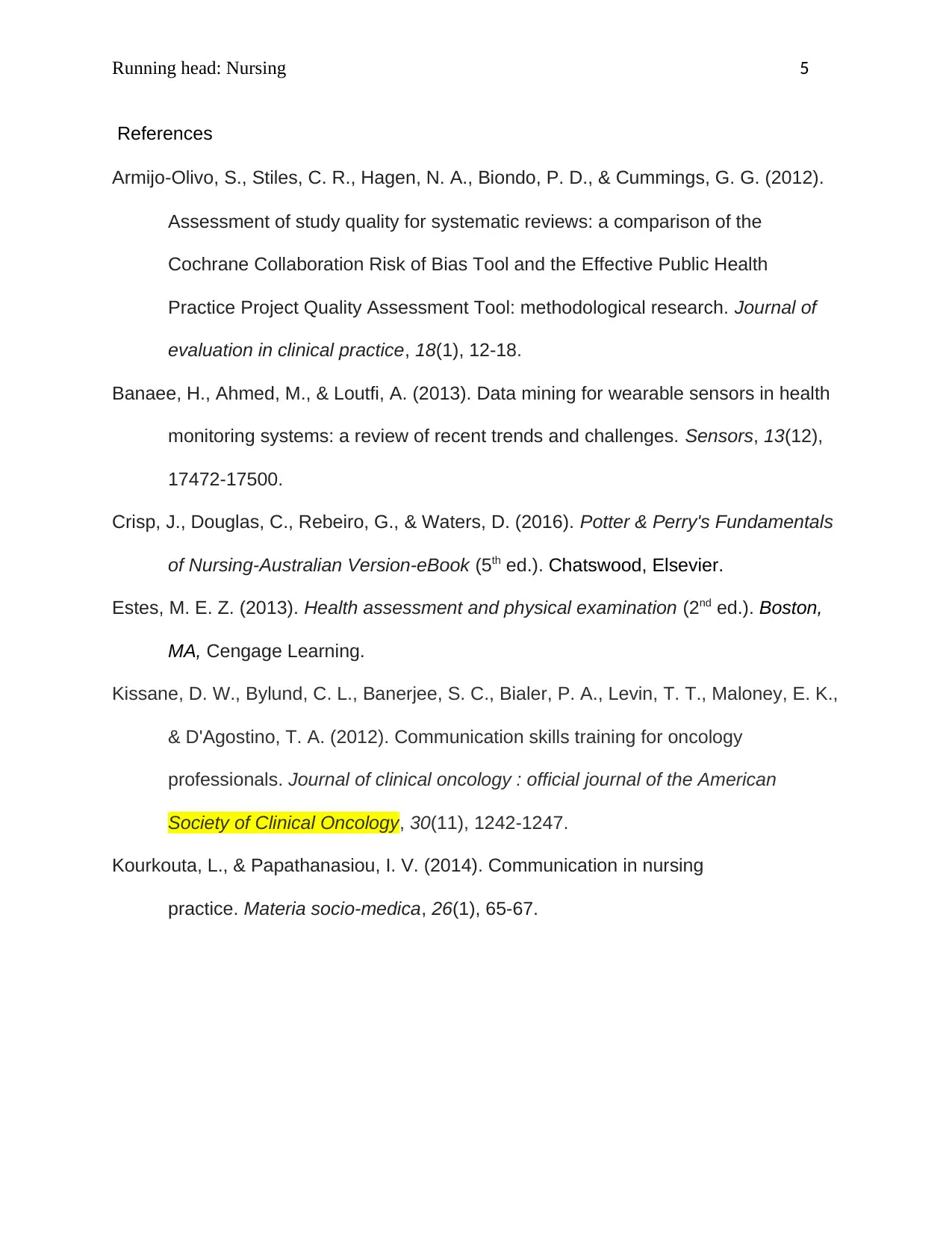
Running head: Nursing 5
References
Armijo‐Olivo, S., Stiles, C. R., Hagen, N. A., Biondo, P. D., & Cummings, G. G. (2012).
Assessment of study quality for systematic reviews: a comparison of the
Cochrane Collaboration Risk of Bias Tool and the Effective Public Health
Practice Project Quality Assessment Tool: methodological research. Journal of
evaluation in clinical practice, 18(1), 12-18.
Banaee, H., Ahmed, M., & Loutfi, A. (2013). Data mining for wearable sensors in health
monitoring systems: a review of recent trends and challenges. Sensors, 13(12),
17472-17500.
Crisp, J., Douglas, C., Rebeiro, G., & Waters, D. (2016). Potter & Perry's Fundamentals
of Nursing-Australian Version-eBook (5th ed.). Chatswood, Elsevier.
Estes, M. E. Z. (2013). Health assessment and physical examination (2nd ed.). Boston,
MA, Cengage Learning.
Kissane, D. W., Bylund, C. L., Banerjee, S. C., Bialer, P. A., Levin, T. T., Maloney, E. K.,
& D'Agostino, T. A. (2012). Communication skills training for oncology
professionals. Journal of clinical oncology : official journal of the American
Society of Clinical Oncology, 30(11), 1242-1247.
Kourkouta, L., & Papathanasiou, I. V. (2014). Communication in nursing
practice. Materia socio-medica, 26(1), 65-67.
References
Armijo‐Olivo, S., Stiles, C. R., Hagen, N. A., Biondo, P. D., & Cummings, G. G. (2012).
Assessment of study quality for systematic reviews: a comparison of the
Cochrane Collaboration Risk of Bias Tool and the Effective Public Health
Practice Project Quality Assessment Tool: methodological research. Journal of
evaluation in clinical practice, 18(1), 12-18.
Banaee, H., Ahmed, M., & Loutfi, A. (2013). Data mining for wearable sensors in health
monitoring systems: a review of recent trends and challenges. Sensors, 13(12),
17472-17500.
Crisp, J., Douglas, C., Rebeiro, G., & Waters, D. (2016). Potter & Perry's Fundamentals
of Nursing-Australian Version-eBook (5th ed.). Chatswood, Elsevier.
Estes, M. E. Z. (2013). Health assessment and physical examination (2nd ed.). Boston,
MA, Cengage Learning.
Kissane, D. W., Bylund, C. L., Banerjee, S. C., Bialer, P. A., Levin, T. T., Maloney, E. K.,
& D'Agostino, T. A. (2012). Communication skills training for oncology
professionals. Journal of clinical oncology : official journal of the American
Society of Clinical Oncology, 30(11), 1242-1247.
Kourkouta, L., & Papathanasiou, I. V. (2014). Communication in nursing
practice. Materia socio-medica, 26(1), 65-67.
1 out of 5
Related Documents
Your All-in-One AI-Powered Toolkit for Academic Success.
+13062052269
info@desklib.com
Available 24*7 on WhatsApp / Email
![[object Object]](/_next/static/media/star-bottom.7253800d.svg)
Unlock your academic potential
Copyright © 2020–2025 A2Z Services. All Rights Reserved. Developed and managed by ZUCOL.





